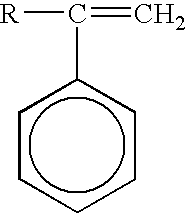Fire control composition and method
a composition and fire technology, applied in the direction of fire extinguishers, pigment pastes, etc., can solve the problems of not being able to make optimal use of water, not able to expel the air necessary, and a large amount of water, so as to achieve optimum absorption and improve drying efficiency
- Summary
- Abstract
- Description
- Claims
- Application Information
AI Technical Summary
Benefits of technology
Problems solved by technology
Method used
Image
Examples
example 2
[0124] A fire-fighting hydrogel composition was prepared by admixing 1000 g of water, 5 g of SAP from BASF, 2 g of FASTUSOL® Red 51L colorant from BASF, and 3 g of calcium carbonate (CaCO3) as an opacifying agent. After admixing, the pH of the hydrogel was adjusted to 7 with sodium hydroxide. The resulting hydrogel composition was spread on cardboard targets approximately 12″×12″ square, then the targets were observed by the naked eye from various distances and under indoor and natural outdoor light conditions Other colorants also were evaluated for visibility. The amounts of colorant and CaCO3 were adjusted to various levels, and the resulting compositions were applied to additional cardboard and colored paper targets in order to optimize the color visibility and opacity of the opaque hydrogel. The visibility of the composition of Example 2 was improved over the visibility of the composition of Example 1, especially at greater distances from the targets.
example 3
[0125] A fire-fighting composition is prepared as described in Example 2, and the composition is spread on various target materials, including dark green colored paper, vinyl siding, cedar shakes, and stucco. The treated target materials then are observed from various distances and under indoor and natural outdoor light conditions. The target materials then are exposed to natural weathering and direct sunlight conditions for a period of 7 days. The hydrogel composition applied to the target materials is observed for amount of drying and degree of color fade. All exposed areas fade significantly during this period to a light orange to clear residue. The above targets then are partially cleaned using fresh tap water and mild abrasion (i.e., sponge or soft scrub material). All residue of the hydrogel composition is easily removed from the target materials.
example 4
[0126] A fire-fighting composition is prepared by adding 1.8 ml of a colorant and 1.8 ml of a high molecular weight polyethylenimine (BASONAL® White FO 1, available from BASF Corporation) to 990 ml of water, then stirring until homogeneous. To the resulting mixture was added about 5.75 gm of a sodium polyacrylate SAP, followed by stirring to provide a homogeneous composition. The three colorants added to separate compositions were FASTUSOL® Red 51L, FASTUSOL® Orange 80LN, and FASTUSOL® Yellow 76LN. A comparative example free of a high molecular weight polyethylenimine and colorant also was prepared.
[0127] A sample of each opacified composition was applied to a 2′×4′ sheet of Astroturf. A sample of uncolored and unopacified SAP hydrogel also was applied to a sheet Astroturf. The uncolored and unopacified SAP hydrogel was not visible on the Astroturf. The color of the Astroturf treated with a composition of the present invention was clearly visible. In an additional sample wherein th...
PUM
| Property | Measurement | Unit |
|---|---|---|
| water soluble | aaaaa | aaaaa |
| viscosity | aaaaa | aaaaa |
| color | aaaaa | aaaaa |
Abstract
Description
Claims
Application Information
 Login to View More
Login to View More - R&D
- Intellectual Property
- Life Sciences
- Materials
- Tech Scout
- Unparalleled Data Quality
- Higher Quality Content
- 60% Fewer Hallucinations
Browse by: Latest US Patents, China's latest patents, Technical Efficacy Thesaurus, Application Domain, Technology Topic, Popular Technical Reports.
© 2025 PatSnap. All rights reserved.Legal|Privacy policy|Modern Slavery Act Transparency Statement|Sitemap|About US| Contact US: help@patsnap.com



